2,4-DINITROBENZENESULFONIC ACID
- CAS NO.:89-02-1
- Empirical Formula: C6H4N2O7S
- Molecular Weight: 248.17
- MDL number: MFCD00066017
- EINECS: 201-876-9
- SAFETY DATA SHEET (SDS)
- Update Date: 2024-11-19 15:53:33
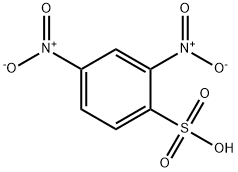
What is 2,4-DINITROBENZENESULFONIC ACID?
Chemical properties
YELLOW TO YELLOW-BROWN CRYSTALLINE POWDER
The Uses of 2,4-DINITROBENZENESULFONIC ACID
Reduction of 2,4-Dinitrobenzenesulfonic Acid gives the colorant intermediate 1,3-diaminobenzene-4-sulfonic acid [88-63-1] as an alternative to the sulfonation of m-phenylenediamine.
Definition
ChEBI: The arenesulfonic acid that is benzenesulfonic acid with two nitro substituents in the 2- and 4-positions.
Production Methods
2,4-Dinitrochlorobenzene is warmed with aqueous sodium sulfite to give an 80 % yield of the sodium salt of 2,4-Dinitrobenzenesulfonic Acid [885-62-1] as yellow needles after salting out. The lower reactivity of 2- and 4- chloronitrobenzene requires much higher temperature for this nucleophilic sulfitation, with too many side reactions to be practicable.
Properties of 2,4-DINITROBENZENESULFONIC ACID
| Melting point: | 95-98 °C(lit.) |
| Density | 1.745 (estimate) |
| refractive index | 1.6430 (estimate) |
| pka | -2.21±0.50(Predicted) |
| form | solid |
| Water Solubility | Soluble in methanol (2.5% w/v), slightly soluble in water. |
| CAS DataBase Reference | 89-02-1(CAS DataBase Reference) |
| EPA Substance Registry System | Benzenesulfonic acid, 2,4-dinitro- (89-02-1) |
Safety information for 2,4-DINITROBENZENESULFONIC ACID
| Signal word | Warning |
| Pictogram(s) |
 Corrosion Corrosives GHS05  Exclamation Mark Irritant GHS07 |
| GHS Hazard Statements |
H314:Skin corrosion/irritation H315:Skin corrosion/irritation H318:Serious eye damage/eye irritation H319:Serious eye damage/eye irritation |
| Precautionary Statement Codes |
P264:Wash hands thoroughly after handling. P264:Wash skin thouroughly after handling. P280:Wear protective gloves/protective clothing/eye protection/face protection. P301+P330+P331:IF SWALLOWED: Rinse mouth. Do NOT induce vomiting. P303+P361+P353:IF ON SKIN (or hair): Remove/Take off Immediately all contaminated clothing. Rinse SKIN with water/shower. P305+P351+P338:IF IN EYES: Rinse cautiously with water for several minutes. Remove contact lenses, if present and easy to do. Continuerinsing. P405:Store locked up. |
Computed Descriptors for 2,4-DINITROBENZENESULFONIC ACID
New Products
4-AMINO-TETRAHYDRO-PYRAN-4-CARBOXYLIC ACID HCL 4-(Dimethylamino)tetrahydro-2H-pyran-4-carbonitrile 4-Aminotetrahydropyran-4-carbonitrile Hydrochloride (R)-3-Aminobutanenitrile Hydrochloride 3-((Dimethylamino)methyl)-5-methylhexan-2-one oxalate 1,4-Dioxa-8-azaspiro[4.5]decane 5-Bromo-2-nitropyridine Nimesulide BP Aceclofenac IP/BP/EP Diclofenac Sodium IP/BP/EP/USP Mefenamic Acid IP/BP/EP/USP Ornidazole IP Diclofenac Potassium THOMAIND PAPER PH 2.0 TO 4.5 1 BOX BUFFER CAPSULE PH 9.2 - 10 CAP SODIUM CHLORIDE 0.1N CVS ALLOXAN MONOHYDRATE 98% PLATINUM 0.5% ON 3 MM ALUMINA PELLETS (TYPE 73) LITHIUM AAS SOLUTION 2-Bromo-1-(bromomethyl)-3-chloro-5-nitrobenzene 2-Bromo-3-nitroaniline N-(3-Hydroxypropyl)-N-methylacetamide 3-Bromo-6-chloropyridazine 4-ethyl-3-nitrobenzoic acidRelated products of tetrahydrofuran
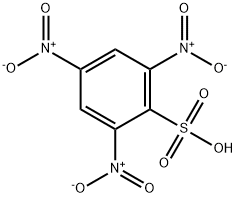
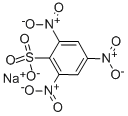

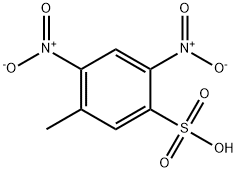


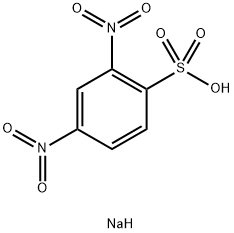
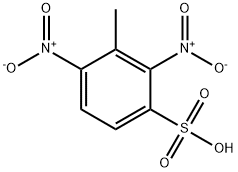
You may like
-
 89-02-1 2,4-dinitrobenzenesulfonic acid 98%View Details
89-02-1 2,4-dinitrobenzenesulfonic acid 98%View Details
89-02-1 -
 1-Methyl-6-oxo-1,6-dihydropyridazine-3-carbonitrile 98%View Details
1-Methyl-6-oxo-1,6-dihydropyridazine-3-carbonitrile 98%View Details
99903-60-3 -
 1823368-42-8 98%View Details
1823368-42-8 98%View Details
1823368-42-8 -
 2-(3-(tert-butyl)phenoxy)-2-methylpropanoic acid 1307449-08-6 98%View Details
2-(3-(tert-butyl)phenoxy)-2-methylpropanoic acid 1307449-08-6 98%View Details
1307449-08-6 -
 Ethyl 3-(furan-2-yl)-3-hydroxypropanoate 25408-95-1 98%View Details
Ethyl 3-(furan-2-yl)-3-hydroxypropanoate 25408-95-1 98%View Details
25408-95-1 -
 2-Chloro-5-fluoro-1-methoxy-3-methylbenzene 98%View Details
2-Chloro-5-fluoro-1-methoxy-3-methylbenzene 98%View Details
1805639-70-6 -
 1784294-80-9 98%View Details
1784294-80-9 98%View Details
1784294-80-9 -
 Lithium ClavulanateView Details
Lithium ClavulanateView Details
61177-44-4
Statement: All products displayed on this website are only used for non medical purposes such as industrial applications or scientific research, and cannot be used for clinical diagnosis or treatment of humans or animals. They are not medicinal or edible.